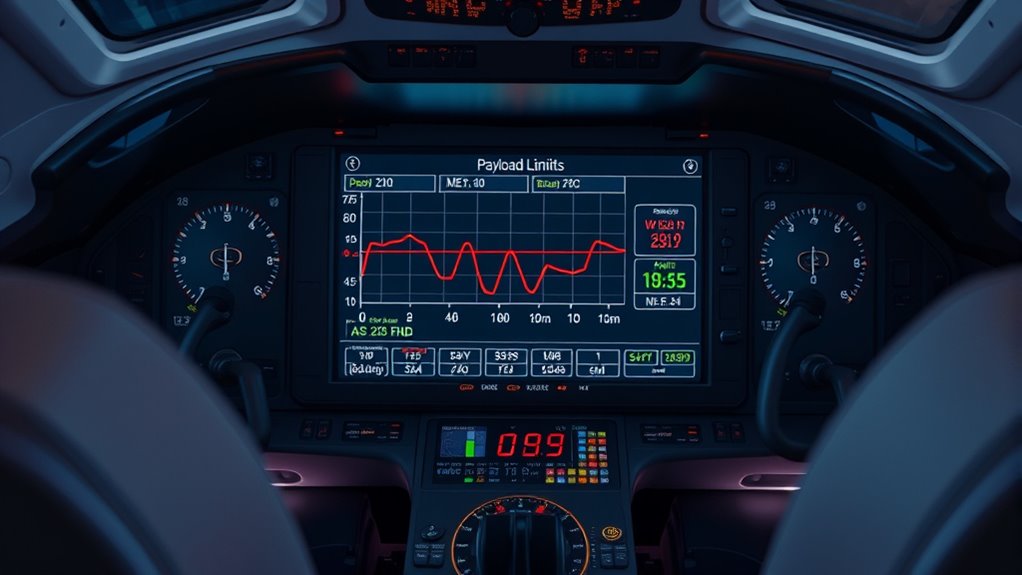When calculating payload, you need to add the weight of passengers, cargo, and fuel, making certain the total stays below the red line—your safety margin indicator. To stay safe, account for each component carefully and adjust loads as needed. Continuously monitor weight levels, so you don’t exceed limits that could compromise safety or performance. Keeping an eye on these factors ensures smooth, secure operation—if you want to know more about balancing these loads, keep exploring further.
Key Takeaways
- Determine the vehicle or aircraft’s empty weight including standard equipment.
- Add passenger, cargo, equipment, and fuel weights to the baseline.
- Calculate fuel weight based on planned consumption and distance.
- Ensure total weight stays below the maximum allowable (red line).
- Continuously monitor and adjust loads to maintain safety margins.

Have you ever wondered how engineers determine the weight a vehicle or aircraft can safely carry? It all starts with accurate weight estimation. When calculating payload, you need to know the maximum allowable weight your vehicle can handle, often marked by a red line or a specific limit. This weight includes everything you plan to carry: passengers, cargo, equipment, and fuel. Accurately estimating this total is vital to guarantee safety and peak performance. If you go over that limit, you risk structural damage, reduced handling, or even catastrophic failure. Conversely, staying below the red line guarantees the vehicle operates within its designed safety margins. Proper weight distribution also plays a crucial role in maintaining vehicle stability and safety. Fuel considerations play a significant role in payload calculations. Fuel adds to the total weight but is also essential for range and mission duration. You must balance how much fuel you carry against your payload needs. Too much fuel, and you’ll reduce the weight available for cargo or passengers; too little, and you might not reach your destination or complete your mission. Engineers typically calculate fuel weight based on distance, expected consumption, and reserve requirements. This careful planning guarantees you’re not carrying excess fuel that eats into payload capacity or risking insufficient fuel for the trip. Weight estimation involves summing up all known weights and subtracting them from your maximum limit. First, determine the empty weight of the vehicle or aircraft, including all standard equipment. Then, add the weight of passengers, cargo, and any additional equipment. Next, factor in fuel weight, which varies depending on your planned fuel load. This process helps you see whether your total payload stays below the red line. If it doesn’t, you’ll need to adjust your load or fuel plans. For example, reducing cargo or passengers can bring the total weight into safe limits. It’s essential to remember that the payload calculation isn’t a one-time task. Conditions change, and so do fuel requirements, passenger numbers, and cargo loads. You need to continuously reassess to stay within safe limits. Modern aircraft and vehicles often have onboard systems that help monitor weight and balance in real-time, alerting you if you’re approaching or exceeding limits. This real-time feedback guarantees you can make adjustments before any safety margin is compromised. Additionally, understanding the total weight capacity of your vehicle ensures you operate within its designed parameters. Ultimately, calculating payload with careful weight estimation and fuel considerations keeps you safe and guarantees your vehicle performs as intended. Staying below the red line isn’t just about obeying a number; it’s about maintaining the integrity of your vehicle and safeguarding everyone on board. With precise planning and regular checks, you can confidently manage your payload and enjoy a safe, efficient journey.
Frequently Asked Questions
How Do Weather Conditions Affect Payload Calculations?
Weather conditions directly impact your payload calculations by influencing aircraft performance. You need to contemplate weather forecasting to anticipate factors like wind, temperature, and turbulence. These elements affect lift, fuel consumption, and safety margins. By using accurate weather data, you can optimize your payload, ensuring your aircraft stays within safe limits. Properly accounting for weather conditions allows you to maximize efficiency while maintaining safety during your flights.
What Are the Safety Margins for Payload Limits?
Oh, the thrill of pushing your aircraft to its limits! But safety margins for payload limits are there to save your day. You must consider cargo capacity and weight distribution carefully, ensuring you don’t exceed the maximum allowed. These margins account for unforeseen factors, keeping you well within safe operational boundaries. Remember, a little caution now prevents major trouble later—because safety isn’t just a suggestion, it’s a necessity.
How Often Should Payload Calculations Be Reviewed?
You should review payload calculations regularly, especially when planning cargo optimization or adjusting weight distribution. Frequent reviews guarantee your aircraft stays within safe limits, preventing overloads and maintaining performance. Consider reviewing whenever there’s a change in cargo, passengers, or fuel loads, or at scheduled intervals per your airline’s procedures. Staying vigilant helps you keep the aircraft below the red line, ensuring safety and efficiency during each flight.
Can Payload Limits Vary Between Different Aircraft Models?
Yes, payload limits can vary between different aircraft models because each one has unique aircraft weight and cargo capacity specifications. You need to verify the aircraft’s specific weight limits to guarantee you stay within safe operating parameters. Always refer to the aircraft’s documentation or weight and balance charts, as exceeding these limits could compromise safety and performance. Adjust your cargo and fuel loads accordingly to stay within the designated payload range.
What Tools Are Best for Real-Time Payload Monitoring?
Did you know improper payload management can lead to safety issues on 90% of flights? For real-time payload monitoring, you should use advanced flight management systems that track weight distribution and fuel management constantly. These tools help you stay within safe limits, ensuring peak performance. By actively monitoring payload, you prevent overloads, improve efficiency, and keep everyone safe during the flight.
Conclusion
So, you thought staying below the red line was simple? Turns out, it’s a delicate dance of precision and luck. You meticulously calculate every pound, yet the universe loves a good joke—just when you think you’re safe, that extra ounce sneaks in. Ironically, the one thing you tried to control most is the hardest to master. In the end, your careful planning might just be the very thing that keeps you from reaching the limit.










